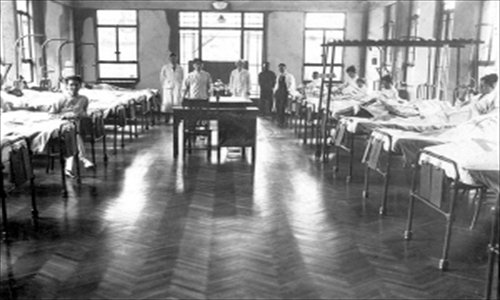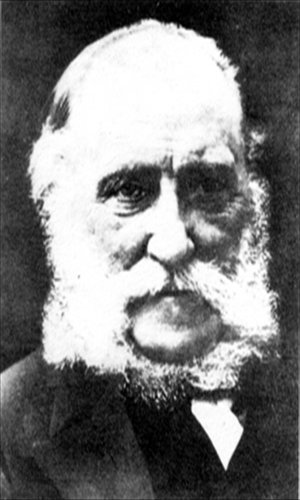Helping the medicine go down

Traditional Chinese Medicine (TCM) has a 5,000-year history in China and, originally, its principles related closely to spiritual beliefs. In ancient China people believed that TCM treatments cured diseases by chasing away evil spirits and ghosts. Western medicine arrived in the Middle Kingdom in the Daoguang period of the Qing Dynasty (1644-1911) along with Westerners during the First Opium War (1840-1842). Established in Guangzhou, Macao and neighboring regions, at first these Western clinics and hospitals were run by missionaries and only treated foreigners. Later they expanded and began treating Chinese.
After the First Opium War the Qing Dynasty government agreed to open five port cities in eastern costal areas - Guangzhou, Xiamen, Fuzhou, Ningbo and Shanghai. Under the agreements foreigners were allowed to come and go freely from these cities. The agreement gave foreigners the right to build churches and hospitals. As the missionaries moved into the cities to bring Christianity with them, they introduced hospitals and Western medical practices as well.
Attractive location
Although Shanghai lagged behind Guangzhou in adopting Western medicine, its unique geographical location and economic and political status attracted the missionaries who began building churches and hospitals and eventually treating ordinary Chinese people. By 1910, Christian groups had built 14 hospitals in Shanghai, the most prosperous city in the Far East. Many of today's city hospitals can trace their origins back to those early times including the Renji Hospital, the Ruijin Hospital, the Shanghai First People's Hospital and the Obstetrics and Gynecology Hospital of Fudan University.
TCM had thrived in Shanghai for thousands of years. In 1820, even though the city was minute by today's standards there were more than 30 TCM pharmacies in Shanghai. After 1843 foreign businessmen began opening Western pharmacies. By 1911 Shanghai had 28 Western pharmacies.
The first Western hospital in Shanghai was "The Chinese Hospital," the forerunner of today's Renji Hospital in Dongfang Road. It was established in 1844 by a British missionary William Lockhart who set it up in a rented house near the then Da Dong Men (Big East Gate). Two years later the hospital moved to what is now Shandong Road Middle, and changed its name to Shantung Road Hospital but it was also known as Renji Yi Guan. At that time the Renji had 60 beds and an outpatient department. Although the facilities were limited, its free medical services attracted a growing number of poor patients.
Prayers and patients
In the first days of the hospital admitting patients it acted as a Christian church at the same time. Patients had to assemble in the hall at 7:30 every morning for Bible readings and prayers. When the outpatients department opened at 11:30 am, anyone seeking treatment had to take part in religious activities before they were given an admission number. Missionaries toured the hospital, preaching and distributing tracts and Bibles every day. Although most patients were only there for the free medical care, some were converted and baptized.
Renji didn't start charging patients until 1905. The poor enjoyed free medical care and food. Charity kept the hospital running. Shanghai was the most open city of China's modern history and as such the people here had not rejected foreign churches and religions as fiercely as other regions. In Shanghai the Western hospitals developed along with Christianity.
The success of Renji inspired other churches and missionaries and soon other church-run hospitals opened. The Shanghai General Hospital was opened in 1864 by the Catholic Church and is today's Shanghai First People's Hospital. St. Elizabeth's Hospital was opened in 1900 by the US Protestant Episcopal Church and merged with St. Luke's Hospital in 1942 to eventually become today's Shanghai Chest Hospital. Guangci Hospital, which was also known as the St. Marie Hospital, was opened in 1907 by the Catholic Church to become today's Ruijin Hospital. Bethel Hospital was established by the Bethel Mission in 1920 and is today the Shanghai Ninth People's Hospital.
But it all began with Renji Hospital. Between 1844 and 1856, Renji had seen 150,000 patients. The outpatient department welcomed between 15,000 and 24,000 patients every year from 1859 to 1867. The hospital also provided treatment for opium addiction and many attended for that reason.
Advanced treatments
The hospital used what was then advanced technology and medical treatments. In 1849 it introduced the use of chloroform as an anesthetic in surgery and in 1876 it became the first hospital in China to carry out surgery in strictly sterile conditions. After it opened separate surgery and medical departments in 1894 the hospital was booming. By 1922 Renji Hospital was treating more than 100,000 outpatients. The same year it became the first hospital in Shanghai with an X-ray machine.
In 1926 the British businessman and philanthropist Henry Lester donated a veritable fortune worth a million taels along with four tracts of land in the city. This allowed the hospital to embark on a major expansion the following year building a six-story hospital with 250 beds. Called the Lester Chinese Hospital it was also known locally as Renji Hospital and the project was completed in 1932. Incidentally the hospital has had several names in its history. During the Cultural Revolution (1966-76) the hospital was called the Gong Nong Bing Hospital (the Workers, Farmers and Soldiers' Hospital) and the Third People's Hospital. In 1984 the hospital reverted to its original name.
In 1932 when the Renji opened as the latest and most modern hospital in the city, 17 percent of its patients were treated in first- or second- class rooms. The rest of the people were accommodated in wards and rooms and their treatment was largely subsidized by charity. By 1949 Renji had 300 beds. Today it exists in three sections: on Dongfang Road, Shandong Road Middle and Lianhang Road. It's famous throughout the country and is attached to the School of Medicine, Shanghai Jiao Tong University.
TCM and Western Medicine have completely different theoretical approaches. When Chinese people first encountered Western medicine, they did not embrace it quickly. Before they opened their hospitals Western missionaries had been distributing medicine on the streets of Shanghai. They carried baskets of Western medicines and drugs and offered these to sick people or anyone they thought needed treatment. Most locals refused to have anything to do with this, many believing the missionaries could be trying to poison or drug them.
When the first church hospitals opened very few Chinese visited. There were rumors that the church doctors drugged women patients and then raped them. Doctors were also held to be evil because they wanted to perform autopsies - in those days Chinese believed it was unforgivable to interfere with a body.
Unlike many social trends, Western medicine gained its foothold in China by first convincing poor people rather than the upper classes that it was effective. Poor people readily accepted the free treatment and food offered by Western doctors - they could not afford to pay TCM practitioners.
Evil spirits
The wealthy took longer to convince because they had had centuries of using TCM, they were familiar with it and its philosophy and they could afford it. They were not educated in science and many still believed that sickness was caused by evil spirits.
But when some of the upper class saw poor people being obviously cured of disease and finding that their TCM treatments were not at all effective, they began to adopt Western medicine for themselves. One key point was that Western medicine was effective a lot more quickly than TCM cures.
Although the original intention of the missionaries was to bring Christianity to China, it was their work in building hospitals not churches that did most good for the nation.
When the missionaries and doctors first arrived in China they were shocked at the lifestyles of most people. Although Chinese understood the connections between good health and food and lifestyles, visitors to the country saw people throwing garbage and body waste into the streets and discharging raw sewage into the rivers. Missionaries recorded that it was common to see people washing vegetables or clothes or drawing water from a river as the bodies of dead animals floated past. It was an ideal environment for infectious diseases.
In the new hospitals the doctors and nurses taught their patients to wash their hands, drink clean water, avoid bad food and regularly bathe themselves. The hospitals began vaccinating people for cowpox, smallpox, malaria and cholera, which were prevalent in the cities. Some missionaries traveled to faraway cities recording the spread of diseases - these reports formed the earliest Western scientific research projects in China.
Western hospitals also introduced modern management systems. Patients were given numbers to establish their places in queues and the staff kept detailed records of everyone who was treated. In 1846, the missionary William Lockhart established a supervisory board for Renji Hospital's development and funding and this panel adopted modern management styles.
The growth of Western hospitals didn't just introduce new technology and a different approach to medicine but it changed China profoundly. By the 1930s Chinese people were obviously preferring Western medicine over TCM.

A new class
China's modern medical schools owe their origins largely to the efforts of the churches and the early missionary doctors. It was normal in the old days that anyone could become a TCM practitioner. There were no professional regulations or educational requirements. If someone studied hard enough and began treating patients with luck he could cure a prominent person and make his reputation. The techniques were often passed down from fathers to sons.
When the first Western doctors arrived in China they had all graduated after years of study at well established and ordered medical schools. They began training their Chinese assistants the way they had been taught and many of the assistants would later practice on their own. William Lockhart, the founder of Renji Hospital, recruited several assistants including his favorite Huang Chunfu who was baptized and continued to work at the hospital for 43 years.
But there was a huge and growing demand for Western medicine and missionaries began establishing medical schools in some of the hospitals where formal Western training was introduced. By the end of the 19th century, 36 church hospitals had trained 268 Chinese doctors who had studied over their six-year courses chemistry, physiology, psychology, pharmacology and anatomy. One noteworthy medical school in Shanghai was founded by missionary Henry William Boone in 1879 at St. Luke's Hospital, a predecessor of today's Shanghai Chest Hospital. In 1896, the school was merged into the medical faculty of St. John's University, Shanghai.
Because it was customary for men and women to be treated separately and by doctors of the same sex, as Chinese women began to accept Western medicine there developed a huge demand for female doctors. In 1902 the Hackett Medical College for Women opened in Guangzhou, at the behest of the US Foreign Missions Board of the Presbyterian Church.
Later Chinese doctors and philanthropists established their own Western medical schools.